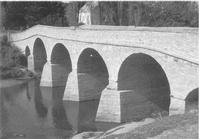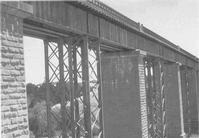


Chapter 6
I Construction During The Settlement Years
II The Use Of Timber As A Structural Material
III Structural Steel
IV Concrete Technology
V Housing
VI Industrialised Pre-cast Concrete Housing
VII Ports And Harbours
VIII Roads
IX Heavy Foundations
X Bridges
XI Sewerage
XII Water Engineering
XIII Railways
XIV Major Buildings
XV Airports
XVI Thermal Power Stations
XVII Materials Handling
XVIII Oil Industry
XIX The Snowy Mountains Scheme
XX The Sydney Opera House
XXI The Sydney Harbour Bridge
XXII Hamersley Iron
XXIII North West Shelf
Sources and References
Index
Search
Help
Contact us

The earliest surviving example of this period is the Richmond Bridge in Tasmania (Fig. 26), built in 1823. The technology required for these structures was within the powers of the building craftsmen and architects with which the Colony had been endowed. As the colony grew, however, transportation moved out of the hands of random developers and government officials were appointed to control it. Australia's first outstanding bridge engineer was David Lennox, appointed Sub-Inspector of Roads in 1832. Three of his stone bridges still stand and demonstrate a comprehension of bridge design apart from building design. An example is the Lansdowne bridge, built in 1836, and still existing (in Sydney) which employs to good effect a flat arch (rather than the semi circular barrel vaults common up to the time) to give the largest existing masonry span from this period.

Settlements and new areas needed to be opened up beyond the mountain barriers and the constraints of the larger rivers. Such an expansion coincided with the industrial revolution in Europe and advances in technology were dominated by the needs of the railways, which began to appear in Australia in the 1850s. Railways, with their heavy loads and flat grade requirements, demanded much more sophisticated technology. Rivers could no longer be crossed by punts where bridging was difficult; flooding of the railway line could not be tolerated, and generous curves were essential. So arose a demand for large bridges. The technology for these bridges and, indeed, many of the materials, were still imported from England and were still extensions of European technology.
An early engineering achievement was the Great Zig Zag railway across the mountains behind Sydney, using several masonry viaducts. As the function of the truss became better understood, truss bridges in timber and metal (cast iron or wrought iron) were used extensively for roads and railways. Similarly, lattice and plate girder bridges were introduced from the 1860s. Even tubular girder bridges, echoing the design techniques of the great British railway engineers, were built in Australia, an example being the Taradale viaduct in Victoria (Fig. 27) built in 1862. So up to the turn of the century bridge technology employed a wide variety of materials and structural forms to cope with the rapid expansion of the country's increasingly important primary industry.

People in Bright Sparcs - Laurie, J. B.; Lennox, David
 |
Australian Academy of Technological Sciences and Engineering |  |
© 1988 Print Edition pages 356 - 357, Online Edition 2000
Published by Australian Science and Technology Heritage Centre, using the Web Academic Resource Publisher
http://www.austehc.unimelb.edu.au/tia/359.html